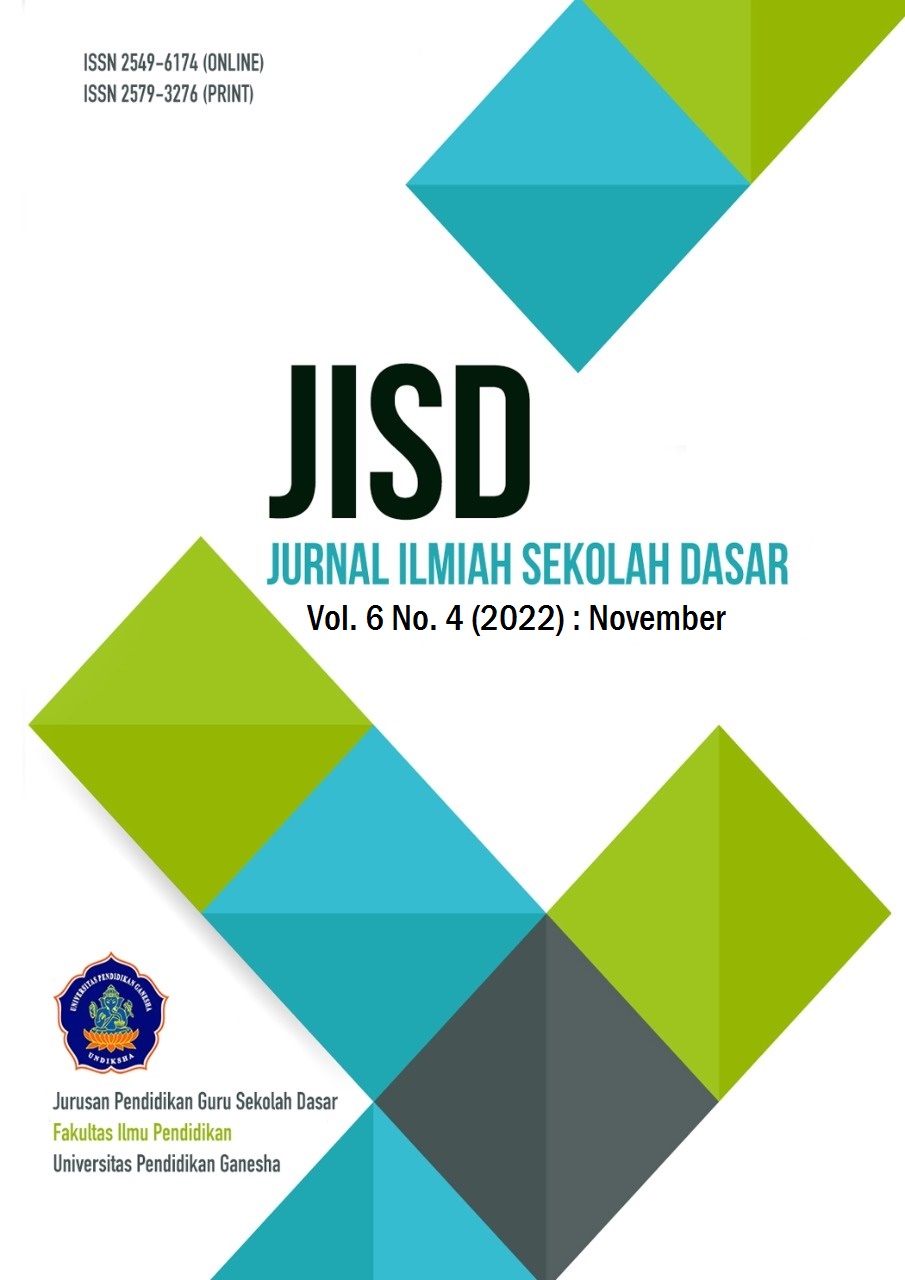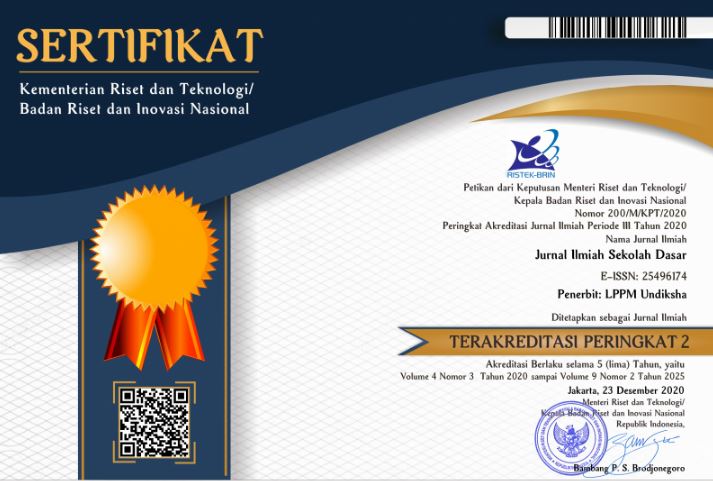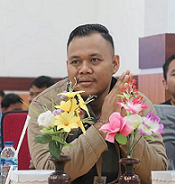Literacy Learning in Early Grades: Teacher Thought on Teaching Literacy
DOI:
https://doi.org/10.23887/jisd.v6i4.49994Keywords:
Literacy, Early Grade, Elementary School TeachersAbstract
The main problem in student's literacy skills in the early grades has not been implemented holistically. In addition, the teacher has not used the right model in literacy learning in the early grades. The main objective of this research was to analyses the process of learning literacy in elementary school. This study used a survey method involving 48 principals and 148 elementary school teachers. Interviews were used as an instrument to describe literacy learning in early grades of elementary schools. Information obtained from the field is tabulated and presented. This research showed that the procedures or models and learning media used by teachers are different. Teachers have made efforts to increase children's motivation in exploring literacy learning. Teachers believe that literacy is a very important need for every individual. Literacy in the early grades plays an important role in determining students learning success. Effective literacy learning in the early grades needs to pay attention to the learning environment and material that suit the needs of students. A pleasant learning experience and adult support can have a positive effect on reading skills. This skill will greatly affect subsequent literacy skills. If literacy learning in the initial class is not strong, it will be difficult for students to build a foundation for literacy in higher grades.
References
Abidin, Y. (2018). Pembelajaran Multiliterasi: Sebuah Jawaban atas Tantangan Pendidikan Abad Ke-21 dalam Konteks Keindonesiaan. Refika Aditama.
Abidin, Y., Mulyati, T., & Yunansah, H. (2017). Developing Literacy Learning Model Based On Multi Literacy, Integrated, And Differentiated Concept At Primary School. Jurnal Cakrawala Pendidikan, 36(2), 156–166. https://doi.org/10.21831/cp.v36i2.13283. DOI: https://doi.org/10.21831/cp.v36i2.13283
Aftab, J. (2015). Teachers’ Beliefs about Differentiated Instructions in Mixed Ability Classrooms: A Case of Time Limitation. Journal of Education and Education Development, 2(2), 94–114. https://eric.ed.gov/?id=EJ1161474. DOI: https://doi.org/10.22555/joeed.v2i2.441
Alabau Rivas, E. (2016). Children’s Literature and Literary Competence Development: a Didactic Proposal Using the Picture Book Amazing Grace in Primary Education. Revista de Filologia, 7, 73–79. https://doi.org/10.14198/itaca2016.7.07. DOI: https://doi.org/10.14198/ITACA2016.7.07
Altun, D. (2019). Preschoolers’ Emergent Motivations to Learn Reading: A Grounded Theory Study. Early Childhood Education Journal, 47(4), 427–443. https://doi.org/10.1007/s10643-019-00939-3. DOI: https://doi.org/10.1007/s10643-019-00939-3
Apriliana, A. . (2016). Picture Word Inductive Model dalam Pembelajaran Memabaca dan Menulis. Pedagogik: Jurnal Pendidikan Sekolah Dasar, 4(1), 1–12. https://doi.org/10.33558/pedagogik.v4i1.1264.
Argina, A. W., Mitra, D., Ijabah, N., & Setiawan, R. (2017). Indonesian PISA Result: What Factors and What Should be Fixed? The 1st Education and Language International Conference Proceedings Center for International Language Development of Unissula, 69–79. http://lppm-unissula.com/jurnal.unissula.ac.id/index.php/ELIC/article/view/1212.
Arianti, B. F. (2018). The Influence of Financial Literacy, Financial Behavior and Income On Investment Decision. Economics and Accounting Journal, 1(1), 1–10. https://doi.org/10.32493/eaj.v1i1.y2018.p1-10. DOI: https://doi.org/10.33122/ijase.v1i6.107
Asyhari, A. (2015). Profil Peningkatan Kemampuan Literasi Sains Siswa Melalui Pembelajaran Saintifik. Jurnal Ilmiah Pendidikan Fisika Al-Biruni, 4(2), 179–191. https://doi.org/10.24042/jpifalbiruni.v4i2.91. DOI: https://doi.org/10.24042/jpifalbiruni.v4i2.91
Baguley, M., Pullen, D. L., & Short, M. (2009). Multiliteracies and Technology Enhanced Education: Sosial Practice and Global Classroom. In Multiliteracies and Technology Enhanced Education: Social Practice and the Global Classroom. Information Science Reference. https://doi.org/10.4018/978-1-60566-673-0.ch001. DOI: https://doi.org/10.4018/978-1-60566-673-0.ch001
Bakri, F., Chaerunnisa, M., Swalaganata, G., Octareissa, A., Rosyadi, H. E., Idhamani, A. P., Minat, M., Siswa, B., Suryaningsih, A., Belajar, M., Mandarin, B., Fitriana, D. A., Wedi, A., Lubis, A. H., Dasopang, M. D., Anak, P., Pelealu, B. N., Afirianto, T., Wardhono, W. S., & Siswa, M. B. (2020). No Title. 3(1), 351–364. https://doi.org/10.51169/ideguru.v4i1.80. DOI: https://doi.org/10.51169/ideguru.v4i1.80
Barnyak, N. C., & McNelly, T. A. (2016). The Literacy Skills and Motivation to Read of Children Enrolled in Title I: A Comparison of Electronic and Print Nonfiction Books. Early Childhood Education Journal, 44(5), 527–536. https://doi.org/10.1007/s10643-015-0735-0. DOI: https://doi.org/10.1007/s10643-015-0735-0
Bekker, T., Bakker, S., Douma, I., van der Poel, J., & Scheltenaar, K. (2015). Teaching children digital literacy through design-based learning with digital toolkits in schools. International Journal of Child-Computer Interaction, 5, 29–38. https://doi.org/10.1016/j.ijcci.2015.12.001. DOI: https://doi.org/10.1016/j.ijcci.2015.12.001
Belo, N., McKenney, S., Voogt, J., & Bradley, B. (2016). Teacher knowledge for using technology to foster early literacy: A literature review. Computers in Human Behavior, 60, 372–383. https://doi.org/10.1016/j.chb.2016.02.053. DOI: https://doi.org/10.1016/j.chb.2016.02.053
Broce, I. J., Bernal, B., Altman, N., Bradley, C., Baez, N., Cabrera, L., Hernandez, G., De Feria, A., & Dick, A. S. (2019). Fiber pathways supporting early literacy development in 5–8-year-old children. Brain and Cognition, 134(December 2018), 80–89. https://doi.org/10.1016/j.bandc.2018.12.004. DOI: https://doi.org/10.1016/j.bandc.2018.12.004
Buckley-Walker, K., Tognolini, J., Lockyer, L., Brown, I., & Caputi, P. (2017). Evaluating the validity of the online multiliteracy assessment tool. Australian Journal of Education, 61(3), 305–327. https://doi.org/10.1177/0004944117729056. DOI: https://doi.org/10.1177/0004944117729056
Calhoun, E. F. (2005). Teaching Beginning Reading and Writing with The Picture Word Inductive Model. In Development. Association for Supervision and Curriculum Development (ASCD).
Camacho, A., Alves, R. A., & Boscolo, P. (2021). Writing Motivation in School: a Systematic Review of Empirical Research in the Early Twenty-First Century. In Educational Psychology Review (Vol. 33, Issue 1). Educational Psychology Review. https://doi.org/10.1007/s10648-020-09530-4. DOI: https://doi.org/10.1007/s10648-020-09530-4
Chubko, N., Morris, J. E., McKinnon, D. H., Slater, E. V., & Lummis, G. W. (2020). Digital storytelling as a disciplinary literacy enhancement tool for EFL students. Educational Technology Research and Development, 68(6), 3587–3604. https://doi.org/10.1007/s11423-020-09833-x. DOI: https://doi.org/10.1007/s11423-020-09833-x
Eithne Kennedy, Elizabeth Dunphy, B. D., & Geraldine Hayes, Thérèse McPhillips, Jackie Marsh, Maura O’Connor, G. S. (2012). Literacy in Early Childhood and Primary Education (3-8 Years). NCCA.
Fadillah, F., & Munandar, D. R. (2021). Analisis kemampuan literasi statistis dalam pembelajaran matematika di masa pandemi. 4(5), 1157–1168. https://doi.org/10.22460/jpmi.v4i5.1157-1168.
Frerejean, J., Geel, M. Van, Keuning, T., & Dolmans, D. (2021). Ten steps to 4C / ID : training differentiation skills in a professional development program for teachers. Instructional Science, 0123456789. https://doi.org/10.1007/s11251-021-09540-x. DOI: https://doi.org/10.1007/s11251-021-09540-x
Gillies, R. M., & Baffour, B. (2017). The effects of teacher-introduced multimodal representations and discourse on students’ task engagement and scientific language during cooperative, inquiry-based science. Instructional Science, 45(4), 493–513. https://doi.org/10.1007/s11251-017-9414-4. DOI: https://doi.org/10.1007/s11251-017-9414-4
Glasow, P. (2005). Fundamentals of Survey Research Methodology. MITRE (Washington C3 Center).
Håland, A., Hoem, T. F., & McTigue, E. M. (2019). Writing in First Grade: The Quantity and Quality of Practices in Norwegian Classrooms. Early Childhood Education Journal, 47(1), 63–74. https://doi.org/10.1007/s10643-018-0908-8. DOI: https://doi.org/10.1007/s10643-018-0908-8
Hartati, T. (2016). Multimedia In Literacy Development at Remote Elementary Schools In West Java. Edutech,. Edutech, 15(3). https://doi.org/10.17509/edutech.v15i3.4873. DOI: https://doi.org/10.17509/edutech.v15i3.4873
Hartati, T., & Heryanto, D. (2019). Pendidikan Bahasa dan Sastra Indonesia Berbasis TPACK dan Multiliterasi di Sekolah Dasar. UPI Press.
Herawati, N. I., Nurihsan, A. J., Hufad, A., & Soendari, T. (2019). Sensory Integration-Based Picture Word Inductive Model (PWIM). 214(Ices 2018), 200–203. https://doi.org/10.2991/ices-18.2019.48. DOI: https://doi.org/10.2991/ices-18.2019.48
Jiang, X. (2018). Exploring young English learners’ perceptions of the Picture Word Inductive Model in China. TESOL International Journal, 13(1), 67–78. https://eric.ed.gov/?id=EJ1247206.
Johnsen, S. K., Fearon-drake, D., Wisely, L. W., Johnsen, S. K., Fearon-drake, D., & A, L. W. W. (2020). A Formative Evaluation of Differentiation Practices in Elementary Cluster Classrooms A Formative Evaluation of Differentiation Practices in Elementary Cluster Classrooms. Roeper Review, 42(3), 206–218. https://doi.org/10.1080/02783193.2020.1765921. DOI: https://doi.org/10.1080/02783193.2020.1765921
Jokinen, P., & Murris, K. (2020). Inhuman hands and missing child: Touching a literacy event in a Finnish primary school. Journal of Early Childhood Literacy, 20(1), 44–68. https://doi.org/10.1177/1468798420904115. DOI: https://doi.org/10.1177/1468798420904115
Junika, N., Izzati, N., & Tambunan, L. R. (2020). Pengembangan soal statistika model PISA untuk melatih kemampuan literasi statistika siswa. Mosharafa: Jurnal Pendidikan Matematika, 9(3), 499–510. https://doi.org/10.31980/mosharafa.v9i3.615. DOI: https://doi.org/10.31980/mosharafa.v9i3.615
Kajamaa, A., & Kumpulainen, K. (2020). Students’ multimodal knowledge practices in a makerspace learning environment. International Journal of Computer-Supported Collaborative Learning, 15(4), 411–444. https://doi.org/10.1007/s11412-020-09337-z. DOI: https://doi.org/10.1007/s11412-020-09337-z
Kaynar, N., Sadik, O., & Boichuk, E. (2020). Technology in Early Childhood Education: Electronic Books for Improving Students’ Literacy Skills. TechTrends, 64(6), 911–921. https://doi.org/10.1007/s11528-020-00520-5. DOI: https://doi.org/10.1007/s11528-020-00520-5
Kennedy et al. (2012). Literacy in Early Childhood and Primary Education. In Literacy in Early Childhood and Primary Education (Issue 15). National Council for Curriculum and Assessment. https://doi.org/10.1017/cbo9781139519397. DOI: https://doi.org/10.1017/CBO9781139519397
Khalid, M. S. (2011). ICT in Education: Secondary Technical Vocational Education and Training Institute Centered Diffusion of Innovation in Rural Bangladesh. In International Technology, Education and Development Conference (pp. 1126–1134). International Association of Technology, Education and Development (IATED). https://vbn.aau.dk/en/publications/ict-in-education-secondary-technical-vocational-education-and-tra.
Kim, J. S., Relyea, J. E., Burkhauser, M. A., Scherer, E., & Rich, P. (2021). Improving Elementary Grade Students’ Science and Social Studies Vocabulary Knowledge Depth, Reading Comprehension, and Argumentative Writing: a Conceptual Replication. Educational Psychology Review. https://doi.org/10.1007/s10648-021-09609-6. DOI: https://doi.org/10.1007/s10648-021-09609-6
Kim, M. S., & Xing, X. (2019). Appropriation of affordances of multiliteracies for Chinese literacy teaching in Canada. Research and Practice in Technology Enhanced Learning, 14(1), 1–14. https://doi.org/10.1186/s41039-019-0095-2. DOI: https://doi.org/10.1186/s41039-019-0095-2
Kim, S. J., & Hachey, A. C. (2020). Engaging Preschoolers with Critical Literacy Through Counter-Storytelling: A Qualitative Case Study. Early Childhood Education Journal. https://doi.org/10.1007/s10643-020-01089-7. DOI: https://doi.org/10.1007/s10643-020-01089-7
Kulju, P., Kupiainen, R., Wiseman, A. M., Jyrkiäinen, A., Koskinen-Sinisalo, K.-L., & Mäkinen, M. (2018). A Review of Multiliteracies Pedagogy in Primary Classrooms. Language and Literacy, 20(2), 80–101. https://doi.org/10.20360/langandlit29333. DOI: https://doi.org/10.20360/langandlit29333
Lange, A. A. (2019). Technology, instructional methods, and the systemic messiness of innovation: improving reading fluency for low socio-economic elementary school students. Educational Technology Research and Development, 67(5), 1333–1350. https://doi.org/10.1007/s11423-019-09675-2. DOI: https://doi.org/10.1007/s11423-019-09675-2
Langub, L. W., & Lokey-Vega, A. (2017). Rethinking Instructional Technology to Improve Pedagogy for Digital Literacy: A Design Case in a Graduate Early Childhood Education Course. TechTrends, 61(4), 322–330. https://doi.org/10.1007/s11528-017-0185-1. DOI: https://doi.org/10.1007/s11528-017-0185-1
Lee, B. C., Pandian, A., Rethinasamy, S., & Tan, D. A. L. (2019). Effects of PWIM in the ESL classroom: Vocabulary knowledge development among primary Malaysian learners. 3L: Language, Linguistics, Literature, 25(4), 179–197. https://doi.org/10.17576/3L-2019-2504-11. DOI: https://doi.org/10.17576/3L-2019-2504-11
Lisenbee, P. S., & Ford, C. M. (2018). Engaging Students in Traditional and Digital Storytelling to Make Connections Between Pedagogy and Children’s Experiences. Early Childhood Education Journal, 46(1), 129–139. https://doi.org/10.1007/s10643-017-0846-x. DOI: https://doi.org/10.1007/s10643-017-0846-x
Mahayanti, N. W. S., Artini, L. P., & Jannah, N. (2017). the Effect of Big Book As Media on Students’ Reading Comprehension At Fifth Grade of Elementary School in Sd Laboratorium Undiksha Singaraja. International Journal of Language and Literature, 1(3), 2549–4287. https://doi.org/10.23887/ijll.v1i3.12544. DOI: https://doi.org/10.23887/ijll.v1i3.12544
Marzano, R., Pickering, D., & Pollack, J. (2001). Classroom Instruction That Works: Research-based Strategies for Increasing Student Achievement. ASCD.
McBreen, M., & Savage, R. (2020). The Impact of Motivational Reading Instruction on the Reading Achievement and Motivation of Students: a Systematic Review and Meta-Analysis. Educational Psychology Review. https://doi.org/10.1007/s10648-020-09584-4. DOI: https://doi.org/10.1007/s10648-020-09584-4
Moroco, C. C., Mata, A. C., Bershad, C., Kotula, A. W., & Hindin, A. (2008). Supported Literacy for Adolescents. Jossey-Bass A Wiley Imprint. DOI: https://doi.org/10.1002/9781118269350
Nevo, E., & Vaknin-Nusbaum, V. (2020). Enhancing motivation to read and reading abilities in first grade. Educational Psychology, 40(1), 22–41. https://doi.org/10.1080/01443410.2019.1635680. DOI: https://doi.org/10.1080/01443410.2019.1635680
Novia, F. (2015). Promoting picture word inductive model (PWIM) to develop students’ writing skill. Premise: Journal of English Education and Applied Linguistics, 4(1). https://www.fkip.ummetro.ac.id/journal/index.php/english/article/view/283. DOI: https://doi.org/10.24127/pj.v4i1.283
Novitasari, K. (2019). Penggunaan Teknologi Multimedia Pada Pembelajaran Literasi Anak Usia Dini. Jurnal Golden Age, 3(01), 50. https://doi.org/10.29408/goldenage.v3i01.1435. DOI: https://doi.org/10.29408/goldenage.v3i01.1435
Nugrahanto, S., & Zuchdi, D. (2019). Indonesia PISA Result and Impact on The Reading Learning Program in Indonesia. 297(Icille 2018), 373–377. https://doi.org/10.2991/icille-18.2019.77. DOI: https://doi.org/10.2991/icille-18.2019.77
Oakley, G., Wildy, H., & Berman, Y. (2020). Multimodal digital text creation using tablets and open-ended creative apps to improve the literacy learning of children in early childhood classrooms. Journal of Early Childhood Literacy, 20(4), 655–679. https://doi.org/10.1177/1468798418779171. DOI: https://doi.org/10.1177/1468798418779171
Paris, A., & Paris, S. (2003). Assessing Narrative Comprehension in Young Children. 38(1), 36–76. https://doi.org/10.1598/RRQ.38.1.3. DOI: https://doi.org/10.1598/RRQ.38.1.3
Pereira, N., Tay, J., Maeda, Y., & Gentry, M. (2019). Differentiation as measured by the Classroom Practices Survey : a validity study updating the original instrument. Learning Environments Research, 22(3), 443–460. https://doi.org/10.1007/s10984-019-09284-z. DOI: https://doi.org/10.1007/s10984-019-09284-z
Pinto, G., Bigozzi, L., Tarchi, C., Accorti Gamannossi, B., & Canneti, L. (2015). Cross-lag analysis of longitudinal associations between primary school students’ writing and reading skills. Reading and Writing, 28(8), 1233–1255. https://doi.org/10.1007/s11145-015-9569-9. DOI: https://doi.org/10.1007/s11145-015-9569-9
Pratiwi, S. N., Cari, C., & Aminah, N. S. (2019). Pembelajaran IPA Abad 21 dengan Literasi Sains Siswa. Jurnal Materi Dan Pembelajaran Fisika (JMPF), 9(1), 34–42. https://doi.org/10.20961/jmpf.v9i1.31612.
Priyambodo, S., & Maryati, I. (2019). Peningkatan kemampuan literasi statistis melalui model pembelajaran berbasis proyek yang dimodifikasi. Mosharafa: Jurnal Pendidikan Matematika, 8(2), 273–284. https://doi.org/10.31980/mosharafa.v8i2.496. DOI: https://doi.org/10.31980/mosharafa.v8i2.496
Putman, R. S. (2017). Technology versus teachers in the early literacy classroom: an investigation of the effectiveness of the Istation integrated learning system. Educational Technology Research and Development, 65(5), 1153–1174. https://doi.org/10.1007/s11423-016-9499-5. DOI: https://doi.org/10.1007/s11423-016-9499-5
Setiawan, E. P. (2019). Analisis muatan literasi statistika dalam buku teks matematika Kurikulum 2013. Pythagoras: Jurnal Pendidikan Matematika, 14(2), 163–177. https://doi.org/10.21831/pg.v14i2.28558. DOI: https://doi.org/10.21831/pg.v14i2.28558
Taboada Barber, A., Buehl, M. M., Kidd, J. K., Sturtevant, E. G., Richey Nuland, L., & Beck, J. (2015). Reading Engagement in Social Studies: Exploring the Role of a Social Studies Literacy Intervention on Reading Comprehension, Reading Self-Efficacy, and Engagement in Middle School Students with Different Language Backgrounds. Reading Psychology, 36(1), 31–85. https://doi.org/10.1080/02702711.2013.815140. DOI: https://doi.org/10.1080/02702711.2013.815140
Thomas, L. J. G., Gerde, H. K., Piasta, S. B., Logan, J. A. R., Bailet, L. L., & Zettler-Greeley, C. M. (2020). The early writing skills of children identified as at-risk for literacy difficulties. Early Childhood Research Quarterly, 51, 392–402. https://doi.org/10.1016/j.ecresq.2020.01.003. DOI: https://doi.org/10.1016/j.ecresq.2020.01.003
Tomlinson, C. A., & Mctighe, J. (2006). Differentiated Instruction Understanding by Design. Association for Supervision and Curriculum Development.
Trainin, G., Wessels, S., Nelson, R., & Vadasy, P. (2017). A Study of Home Emergent Literacy Experiences of Young Latino English Learners. Early Childhood Education Journal, 45(5), 651–658. https://doi.org/10.1007/s10643-016-0809-7. DOI: https://doi.org/10.1007/s10643-016-0809-7
Virinkoski, R., Lerkkanen, M. K., Holopainen, L., Eklund, K., & Aro, M. (2018). Teachers’ Ability to Identify Children at Early Risk for Reading Difficulties in Grade 1. Early Childhood Education Journal, 46(5), 497–509. https://doi.org/10.1007/s10643-017-0883-5. DOI: https://doi.org/10.1007/s10643-017-0883-5
Walpole, S., & McKenna, M. (2007). Differentiated reading instruction. The Guilford Press.
Yang, G., Badri, M., Al Rashedi, A., & Almazroui, K. (2018). The role of reading motivation, self-efficacy, and home influence in students’ literacy achievement: a preliminary examination of fourth graders in Abu Dhabi. Large-Scale Assessments in Education, 6(1), 4. https://doi.org/10.1186/s40536-018-0063-0. DOI: https://doi.org/10.1186/s40536-018-0063-0
Zhao, M., & Lornklang, T. (2019). The Use of Picture Word Inductive Model Focusing on Chinese Culture to Promote Young Learners’ English Vocabulary Acquisition. Advances in Language and Literary Studies, 10(4), 105. https://doi.org/10.7575/aiac.alls.v.10n.4p.105. DOI: https://doi.org/10.7575/aiac.alls.v.10n.4p.105
Downloads
Published
How to Cite
Issue
Section
License
Copyright (c) 2022 Anggi Apriliana, Tatat , Dadang , Rahman

This work is licensed under a Creative Commons Attribution-ShareAlike 4.0 International License.
Authors who publish with the Journal Ilmiah Sekolah Dasar agree to the following terms:
- Authors retain copyright and grant the journal the right of first publication with the work simultaneously licensed under a Creative Commons Attribution License (CC BY-SA 4.0) that allows others to share the work with an acknowledgment of the work's authorship and initial publication in this journal.
- Authors are able to enter into separate, additional contractual arrangements for the non-exclusive distribution of the journal's published version of the work (e.g., post it to an institutional repository or publish it in a book), with an acknowledgment of its initial publication in this journal.
- Authors are permitted and encouraged to post their work online (e.g., in institutional repositories or on their website) prior to and during the submission process, as it can lead to productive exchanges, as well as earlier and greater citation of published work. (See The Effect of Open Access)











